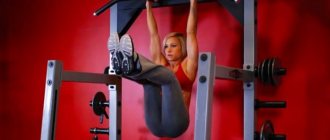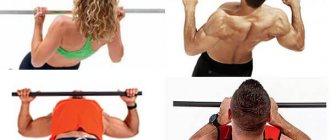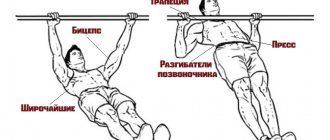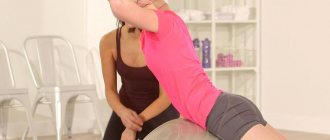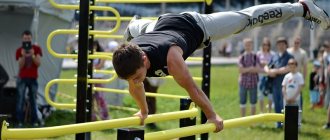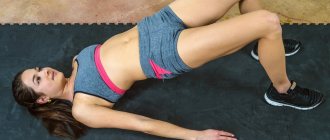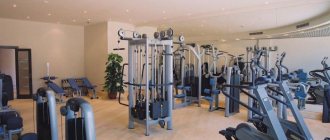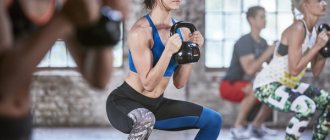The horizontal bar is one of the pillars of street and home training. This is because it does not require much time, yet it gives a comprehensive result for the body. Exercises on the horizontal bar can be simple and familiar, or complex.
Today we will talk about the features of training with a horizontal bar and the basic exercises that you can use.
The benefits of exercising on the horizontal bar
In fact, this is a truly unique and versatile tool with which you can build a healthy, strong and strong body. There are many variations of pull-ups and additional exercises, such as hanging leg raises, but what have you - I think you’ve seen a lot of videos and photos of exercises on the horizontal bar.
About 6-7 years ago, the workout movement gained unprecedented popularity. We are talking specifically about our region, because in the West they have long been engaged in extreme training on street sites.
By starting with your own bodyweight, you can get into shape so you can begin working with additional weights if desired.
In most cases, standard exercises are enough for ordinary people to help them first form a toned body and maintain that shape in the future.
Over time, the trend for outdoor activities began to subside, but then intensified again. After the wave of popularity, all that remained was a dry awareness of the advantages and disadvantages of outdoor training.
Exercises in the gym - tips for choosing the best set of exercises. Recommendations for beginners and tips on how to practice correctly (85 photos)A set of exercises for gaining weight - basic exercises and recommendations for selecting weights for exercises
We perform squats with dumbbells - a description of the technique of performing the exercise. Subtleties and secrets of squats for girls (125 photos)
The latter include only two - relative dependence on weather conditions and limits in gaining muscle mass.
For many people, the main benefit was saving time. After all, in 30 minutes you can do both exercises for the abs on the horizontal bar and for the rest of the body.
Once the masses realized that you don't have to be just huge, because health plays a vital role in the whole movement, fitness and street sports began to gain an audience again.
Execution technique
There are features in each pull-up variation. There is only one thing in common - you need to try to first bring the shoulder blades together, and only then bend the elbows.
Classic medium grip pull-up
This is a medium straight grip, that is, the palm in the hang is directed away from the face of the person performing the exercise. If the palm and fingers point forward towards the face, then this is a reverse grip.
This pull-up option is suitable for those who need to pass a test in a military or physical education institution; it develops the overall strength of the back muscles. For beginners, this pull-up has a lot of advantages - first of all, it develops the biceps and back in a balanced way.
The sequence of actions is as follows:
- You need to grab the bar with a straight medium grip shoulder-width apart, a slightly wider grip is allowed - 2-3 cm, but not narrower;
- They climb onto the high crossbar using a support or from a jump. The second option is not recommended for beginners, whose weak ligaments may not provide stability in the shoulder joint. Simply hang on a low bar with your knees bent;
- First you need to stabilize your shoulder blades and shoulders while hanging. To do this, you should stop swaying and bring your shoulder blades towards your spine so that your shoulders seem to “open” to the sides;
- After this, a pull-up is performed - the chest is pulled towards the bar, the elbows are bent and moved to the sides. The body is held at a slight angle to the crossbar;
- As soon as you touch the crossbar at the top, you should smoothly lower down;
- The work takes place in a controlled style, raising and lowering the body along an arched trajectory; a straight line can be drawn only if you take the athlete’s tailbone as a reference point. The shoulders arc every time the athlete pulls up and down
This version of pulling up requires control over the lowering too. If you constantly lower yourself into a “dead hang,” that is, fully extend your elbow and shoulder joints, the movement will be much more difficult. Beginners are not recommended to work from a “dead hang”; this is a variation for intermediate ones.
How to Learn to Do Pull-Ups - 5 SIMPLE STEPS (Pull-Ups on the Horizontal Bar for Beginners)
Wide grip pull-up technique
There is little difference here, except that it is almost impossible for a complete beginner to do this exercise right away without any preparation. The movement is anatomically more complex; the wider the shoulders and the shorter the arms, the more difficult it is.
The exercise is performed like this:
- Hanging on the horizontal bar is taken with a grip 5-10 cm wider than the shoulders, but it should be comfortable; if the athlete experiences pain at the start of the exercise, the grip is too wide;
- As you exhale, the shoulder blades are brought together to the spine, the chest seems to be pushed forward, the arms are bent at the elbows, and the chest is pulled up to the crossbar;
- As you inhale, smoothly return to the starting position;
- In the lower part of the amplitude, you cannot relax the body too much, so that the shoulders go to the ears. This will create unnecessary tension in the trapezius when performing the movement, and will not allow the back muscles to be pumped effectively.
In the professional literature, this exercise is also called a wide pronated grip pull-up.
Narrow reverse grip
Many trainers recommend starting with this variation for women and those who have a genetically weaker back.
The technique is like this:
- The hang is accepted with straight arms, palms shoulder-width apart, you should carefully stretch your arms up, grab onto the horizontal bar so that it lies in the middle of your palm, and not on your fingers;
- This exercise is the only variation where the first movement is bending at the elbow joint. As you exhale, you need to bend your elbows and bring your chest to the horizontal bar;
- The lowering is slow; a beginner also does not need to go into a “dead hang” with elbows inserted.
Important note: The narrow reverse grip is better for training the shoulder muscles, but is not recommended for those with rotator cuff problems. In case of shoulder injury, a medium straight grip is optimal, and only after rehabilitation.
Pull-up on a horizontal ladder
This is not quite a pull-up in the classical sense of the word. The athlete's feet are on the floor. To perform this movement, you need to hang straight on the bar so that your back drops down and place your feet on the floor. Next, the back is brought out parallel to the crossbar, and the arms are perpendicular.
The exercise itself resembles a pull-up due to similar mechanics, but most of all it resembles a mid-block row to the belt. This movement develops the lats and prepares the athlete for a conventional pull-up.
“Australian” pull-ups are also done on ladders on the playground. Here it is important to hang so that your shoulders are at the level of the bars on which your arms are fixed, and your feet are secured so that the spine is in a plane parallel to the floor.
It is worth progressing towards a regular pull-up when you can perform the Australian pull-up for 15-20 repetitions.
Progression in pull-ups looks like this - Australian, negative repetitions, pull-ups with a rubber shock absorber, classic pull-ups.
GRIP DIFFERENCE IN PULL-UPS. 6 Types. BIOMECHANICS
Effect on the body
Scientists and doctors have already proven that exercises on the horizontal bar for all muscle groups have a positive effect on the overall health of a person.
Simple regular pull-ups, during which you use only your personal grip, help relieve constant stress from the spine and strengthen the muscle corset.
In addition, posture improves, especially in cases with the initial stage of scoliosis, and back injuries become less of a threat.
Contraindications
As with any sport, the horizontal bar exercise program has its contraindications. There is an opinion among people that exercises on the horizontal bar are not only useful, but almost miraculous and can help with many diseases. Alas, this is not entirely true.
The best dumbbell press - advice from professionals and basic variations of the basic exercise (75 photos)How to do the plank exercise? Step-by-step description of the correct technique and features of the exercise
Yoga stretching exercises - complexes for beginners and stages of achieving high results (110 photos and videos)
Exercising on the horizontal bar definitely brings benefits, but there are diseases and health problems that such a sport will only harm. For example, intervertebral hernia. Exercises on the horizontal bar involve stretching the vertebra, which in turn will greatly harm the patient with a hernia.
This also includes protrusion. If you have serious illnesses, or have recently experienced severe injuries, consult your doctor for advice and consultation before starting to exercise on the horizontal bar.
The same story applies to sprains, ligament tears and joint injuries. We are talking specifically about the arms and back, because the main load goes directly to these parts of the body.
Separately, I would like to highlight excessive excess weight. Since we work with our own weight on the horizontal bar, the entire load falls on the muscles, ligaments and joints.
If you haven't exercised before and are obese, there is a chance that you could injure your ligaments or joints. To do this, you first need to do cardio and lose weight.
Lewis Armstrong course
Lewis Armstrong created one of the most popular pull-up programs in the world of sports. It is suitable for both experienced professionals and people who do not really know how to do pull-ups. The result becomes obvious already after 4 weeks of classes, when the established standard is achieved. However, this scheme has no special boundaries. The number of repetitions of the exercise can be expanded to 100 times or more per day.
The class pattern resembles a regular work week. You need to work for five days, and Saturday and Sunday are days off. Every day a new program awaits the athlete and the only similarity is the morning push-ups. You need to do them as many times as possible and repeat this for 3 approaches. You should start doing pull-ups only 5 hours after the push-ups. It is unacceptable to modify the program at your own request and in exceptional cases you can remove 1 push-up. Lewis Armstrong's training complex looks like this:
On the first day, the athlete will do 5 approaches at maximum effort. The number of repetitions depends on his body. For a beginner, 5 is enough, and for a professional, 25; On the second day, the program is built on a pyramid basis. Pull-ups begin from the minimum, and with each approach 1 repetition is added; For day 3, 9 approaches are prepared and the grip changes every 3. The number of pull-ups is purely individual. For example, if an athlete performs an exercise 15 times, then he will have to do 9 sets of 15 repetitions; On day 4, the number of approaches is selected individually depending on the athlete’s capabilities
The most important thing is to have as many of them as possible. In each approach you need to do the same number of pull-ups; The fifth day will be a repetition of the most difficult training day.
The main essence of the program is to try to do 1 more pull-up in a new approach. Gradually, the muscles will become increasingly stronger, and the figure of one hundred repetitions will soon be conquered by the athlete. However, before such a hard workout, you must warm up your muscles to avoid injury.
All pull-up training programs are designed for the athlete’s initial strength, so you need to select a complex for yourself based on this criterion. Gradually, even a person who does not know how to do pull-ups will be able to do this exercise on a par with professionals. To do this, it is enough to work hard and not give up.
https://youtu.be/TuwmjquxcRU
Training program
During my school years, I didn’t think for a long time about what exercises to do on the horizontal bar - we went and did it. However, this approach had one noticeable negative side that surfaced over time - overtraining.
We worked out every day, not realizing that the muscles need to be given time to recover and rest. As a result, severe fatigue set in, which did not go away until we took a break from training.
If you are not a fanatic, then 3 times a week will be enough for you. There will be at least 48 hours between workouts, during which the muscles will have time to recover.
Facial exercises - types of the best procedures and techniques for performing the exercises necessary for a facelift (135 photos and videos)Review of exercises for men - the most effective comprehensive workouts at home and in the gym (120 photos and videos)
A set of exercises on simulators - programs for beginners and training tips for women and men (105 photos)
And we shouldn’t forget about nutrition either. If your diet is low in protein, but you train a lot, the result will be very weak, despite all your efforts.
Nutrition accounts for 60% of the final result, so pay appropriate attention to it.
Exercises for girls and beginners
Australian pull-ups
- Go to a small horizontal bar, parallel bars or sports vertical ladder (the main thing is that the crossbar is somewhere at the level of your ribs or even lower).
- Grasp the bar with a normal grip.
- Place your legs forward so that you assume a kind of lying position, only with your arms up.
- Fix yourself on the ground with your heels so as not to ride when you rise, and lift your body until it touches your chest.
Try to relax your legs to shift the center of gravity to your upper body and increase the load on your arms.
Negative jumping pull-ups
- Grab the horizontal bar with any grip (depending on what you are training at the moment).
- Jump, helping yourself with your hands so that your chin is above the bar.
- Fix yourself in this position and slowly lower yourself.
This will help you gain strength in your arms and is a great exercise if you are not good at doing pull-ups.
Standard pull-ups
- Grab your hands shoulder-width apart, fingers facing away from you.
- Pull yourself up until your chin is behind the bar.
- If the elbows are turned out, then the lats and back will be pumped.
- When they are directed forward, the load goes to the forearm, triceps and chest.
If you find it difficult, you can use a little rocking.
Reverse grip pull-ups
- Grasp the bar with your fingers facing you.
- Pull yourself up to your chin.
- Don't go all the way down.
This exercise is good for biceps and chest. When you start lifting, you push yourself with your back and then with your arms, so you don't have to go all the way down. There are other exercises for the back.
Pull-up with knees bent
- Use a straight grip, with your fingers facing away from you.
- Place your hands shoulder-width apart.
- Bend your legs at the knees and lift them parallel to the floor.
- Pull yourself up to your chin.
An excellent exercise for girls, as it pumps almost the entire body at once. Moreover, due to the static nature, it is a good way to strengthen the core.
Raising the knees to the body
- Grasp the horizontal bar with an overhand grip.
- Raise your knees to your chest.
Make sure that your body does not swing in different directions. Work only with your abs, not your back.
